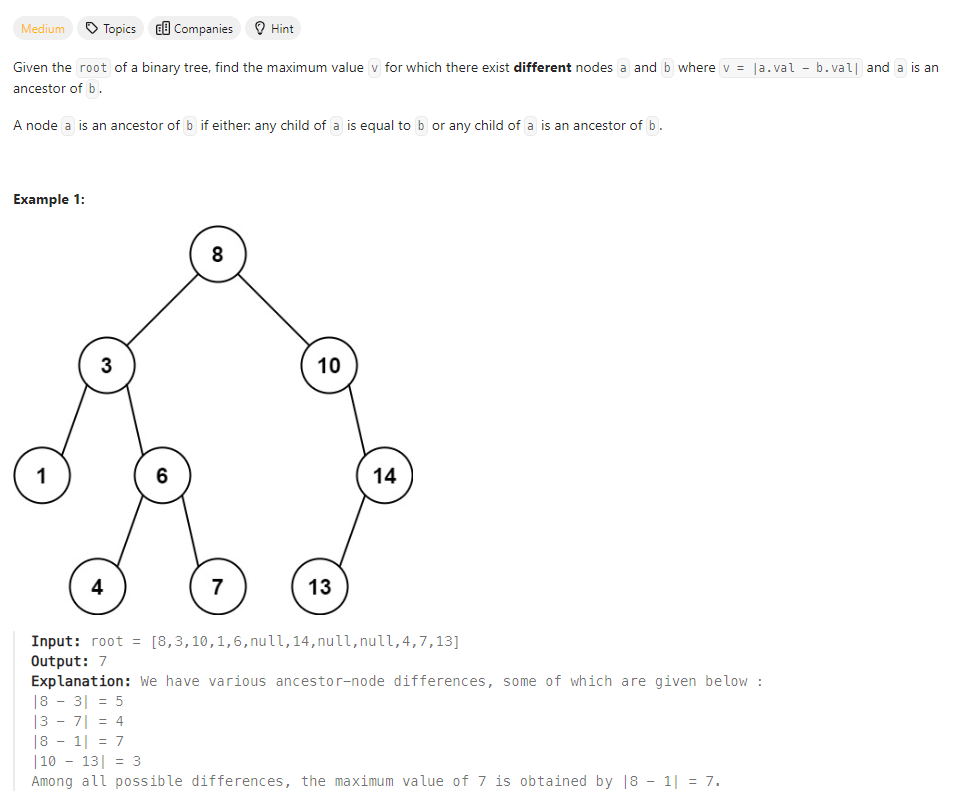Problem of The Day: Maximum Difference Between Node and Ancestor
Brute Force
Problem Statement
Intuition
The problem asks us to find the maximum absolute difference between any two nodes in a binary tree such that one is an ancestor of the other. The initial idea is to perform a depth-first traversal of the tree and, for each node, compare its value with the values of its ancestors to find the maximum difference.
Approach
I decided to use a depth-first traversal approach, where a helper function is used to compare the current node’s value with its ancestors and update the result with the maximum difference found so far. The main function, maxAncestorDiff, initiates the traversal by calling a depth-first search (dfs) function.
The helper function takes two parameters: the current node (curr_node) and the value of its ancestor (ancestor_val). It compares the absolute difference between the current node’s value and its ancestor’s value with the current result and updates it if a larger difference is found. Then, it recursively calls itself for the left and right children of the current node.
Complexity
- Time complexity:
The time complexity of the provided solution is O(n), where n is the number of nodes in the binary tree. Here’s why:
- The
dfsfunction is called once for each node in the tree. In the worst case, every node is visited once. - Inside the
dfsfunction, thehelperfunction is called for each node, and it compares the node’s value with its ancestors. The work done for each node is constant (O(1)) within thehelperfunction. - As a result, the overall time complexity is proportional to the number of nodes in the tree, making it O(n).
- The
- Space complexity: O(h), where h is the height of the tree. This is due to the recursive nature of the depth-first traversal, and the maximum recursion depth is determined by the height of the tree.
Code
class Solution:
def maxAncestorDiff(self, root: Optional[TreeNode]) -> int:
result = 0
def helper(curr_node, ancestor_val):
nonlocal result
if not curr_node:
return
result = max(result, abs(ancestor_val - curr_node.val))
helper(curr_node.left, ancestor_val)
helper(curr_node.right, ancestor_val)
def dfs(node):
if not node:
return
helper(node, node.val)
dfs(node.left)
dfs(node.right)
dfs(root)
return result
Improve Algorithm
Intuition
The problem requires finding the maximum absolute difference between any two nodes in a binary tree such that one is an ancestor of the other. The initial approach is to perform a depth-first traversal while keeping track of the current minimum and maximum values encountered along the path to each node.
Approach
The solution introduces a dfs function that takes three parameters: the current node (node), the current minimum value along the path (curr_min), and the current maximum value along the path (curr_max). The function updates curr_min and curr_max based on the current node’s value, calculates the absolute difference between them, and updates the result if a larger difference is found.
By updating the minimum and maximum values as we traverse the tree, we avoid the need for a separate helper function and eliminate the requirement for two depth-first searches. This optimization reduces the redundancy in the algorithm.
Complexity
-
Time complexity: The time complexity is O(n), where n is the number of nodes in the binary tree. Each node is visited exactly once, and the work done for each node is constant.
-
Space complexity: The space complexity is O(h), where h is the height of the tree. This is due to the recursive nature of the depth-first traversal, and the maximum recursion depth is determined by the height of the tree. The space used for each recursive call is constant.
Code
# Definition for a binary tree node.
# class TreeNode:
# def __init__(self, val=0, left=None, right=None):
# self.val = val
# self.left = left
# self.right = right
class Solution:
def maxAncestorDiff(self, root: Optional[TreeNode]) -> int:
result = 0
def dfs(node, curr_min, curr_max):
nonlocal result
if not node:
return
curr_min = min(curr_min, node.val)
curr_max = max(curr_max, node.val)
result = max(result, abs(curr_max - curr_min))
dfs(node.left, curr_min, curr_max)
dfs(node.right, curr_min, curr_max)
dfs(root, root.val, root.val)
return result
